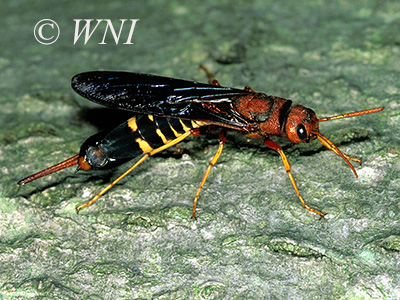| Horntails (Siricidae) |
The Siricidae includes 2 subfamilies (Siricinae and Tremecinae), 10-11 contemporary genera, and ca. 120-150 species. The family is widely distributed in the forests of North and northern Central America, Cuba, Eurasia (including South-East Asia), New Guinea, and Africa. These are large, non-social, stingless wasps with a short abdominal dorsal projection in both sexes (it encases a long, slender ovipositor in the female). Length 10-50 mm (not counting the ovipositor). Adults are black, brown, or blue, often with yellow segments or bands. The larva is wood-boring and may take 1-3 years to develop. When females emerge, they mate, and then seek out stressed, wounded of dying trees (e.g., in recently burned areas), and deposits eggs beneath the bark. The Siricinae specialize in conifers, and Tremicinae in angiosperm trees. The adults feed on the sap exuded from trees or do not feed. Horntails are parasitized by the Ichneumonidae wasps (mainly Megarhyssa spp.), and also the Ibaliidae.
 |
Pigeon Horntail (Tremex columba) |
|
| Unauthorized use of our images is NOT permitted. | ||
| Hotlinking or "pinning" of our images to websites is STRICTLY PROHIBITED. | ||
| Copyright © Michael Patrikeev - All Rights Reserved | ||
| |
||





